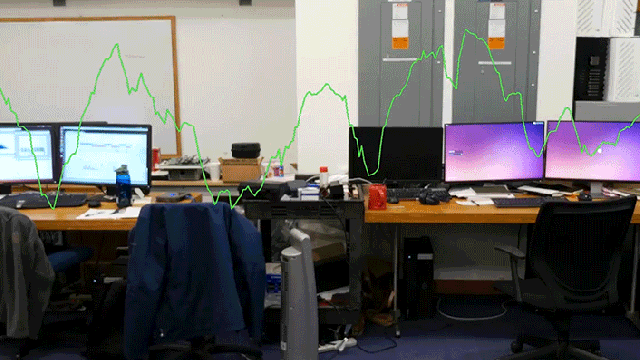For years, we’ve been told that strapping a fitness tracker to your wrist is a great way to track your physical activity and fitness level. But researchers at MIT’s Computer Science and Artificial Intelligence Laboratory have come up with a non-invasive, non-wearable way to do the same thing — and more accurately — using invisible wireless signals.
[referenced url=”https://gizmodo.com.au/2017/04/most-of-us-dont-need-a-fitness-tracker/” thumb=”https://i.kinja-img.com/gawker-media/image/upload/t_ku-large/m6ouz9ajywbctypcnlhi.jpg” title=”Most Of Us Don’t Need A Fitness Tracker” excerpt=”Fitness trackers aren’t what they used to be. The fad gadget you strap to your wrist has seen a precipitous fall in the last year. Pebble closed its doors after releasing a solid fitness tracker, and Fitbit has struggled (though we liked its new Fitbit Alta HR). There’s also the fact that fitness trackers, while great for athletes, seem to not actually help most of us lose weight.”]
The team developed a new device called the WiGait, which looks like an antenna-less Wi-Fi router mounted on a wall. It blasts a low-power wireless signal, which emits about one-hundredth the amount of electromagnetic radiation as a smartphone does, and analyses how that signal bounces off a person’s body as they walk by to determine their speed.
A wearable fitness tracker can only crudely estimate the speed someone is walking by counting their steps, and fancier wearables with built-in GPS don’t work indoors, where satellite signals are blocked. Using wireless signals, the MIT researchers claim that WiGait can measure a person’s speed and stride length accurately at least 85 per cent of the time. It can also keep tabs on multiple people all at the same time. Details of the team’s new device can be found in an accompanying paper.
Recently, there’s been more credence given to the idea that how a person walks can be used as a solid indicator of their health. And conditions like Parkinson’s, multiple sclerosis and even Alzheimer’s often result in symptoms that impair how a patient walks.
The WiGait sensors could be installed in individual houses, long-term care facilities, even nursing homes, and used to monitor how elderly patients are moving about, and how that’s changed over time, revealing how far a condition has progressed. But it could also reveal when a patient’s symptoms have improved, thanks to changes in medication, or a new physical therapy routine.
WiGait doesn’t require wearables that have to be charged every night, or synced to a mobile device. It’s also unobtrusive — in theory, you could just stick one of these bad boys on your wall and forget it’s there, quietly monitoring your every move. Would it replace the fitness tracker you wear outdoors for a long run? Not yet. But there are few places left on Earth that aren’t blanketed by mobile phone and other wireless signals, which, perhaps, will one day be co-opted into a giant version of WiGate that keeps tabs on everyone in a given area.
On second thought, maybe this isn’t such a great idea after all.
[MIT News]
